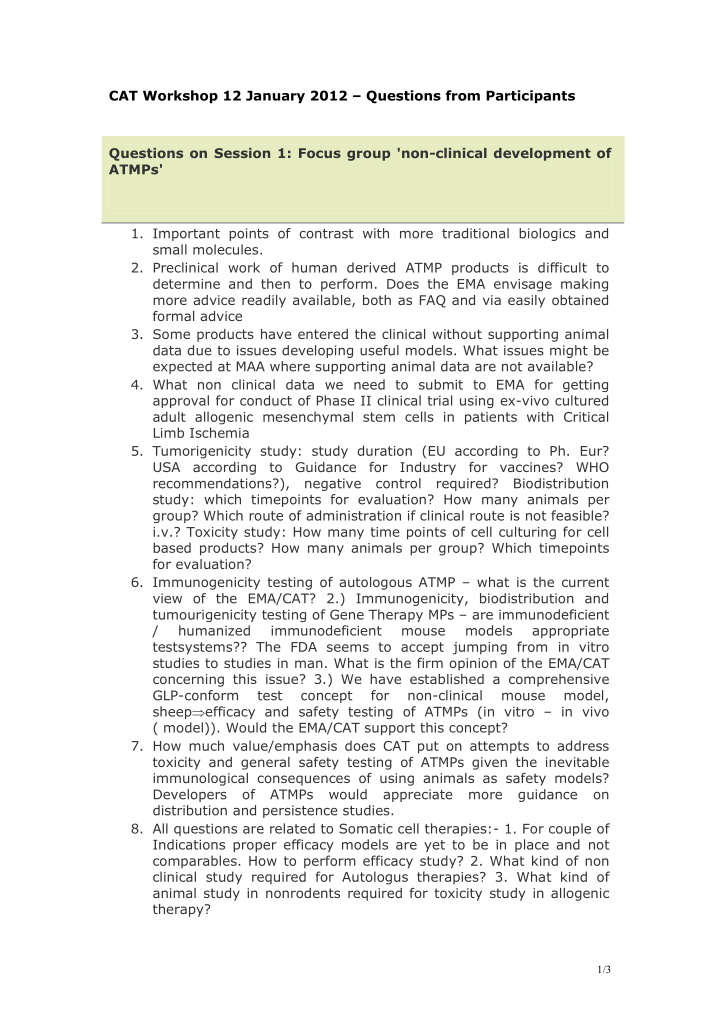



CAT Workshop 12 January 2012 – Questions from Participants Questions on Session 1: Focus group 'non-clinical development of ATMPs' 1. Important points of contrast with more traditional biologics and small molecules. 2. Preclinical work of human derived ATMP products is difficult to determine and then to perform. Does the EMA envisage making more advice readily available, both as FAQ and via easily obtained formal advice 3. Some products have entered the clinical without supporting animal data due to issues developing useful models. What issues might be expected at MAA where supporting animal data are not available? 4. What non clinical data we need to submit to EMA for getting approval for conduct of Phase II clinical trial using ex-vivo cultured adult allogenic mesenchymal stem cells in patients with Critical Limb Ischemia 5. Tumorigenicity study: study duration (EU according to Ph. Eur? USA according to Guidance for Industry for vaccines? WHO recommendations?), negative control required? Biodistribution study: which timepoints for evaluation? How many animals per group? Which route of administration if clinical route is not feasible? i.v.? Toxicity study: How many time points of cell culturing for cell based products? How many animals per group? Which timepoints for evaluation? 6. Immunogenicity testing of autologous ATMP – what is the current view of the EMA/CAT? 2.) Immunogenicity, biodistribution and tumourigenicity testing of Gene Therapy MPs – are immunodeficient / humanized immunodeficient mouse models appropriate testsystems?? The FDA seems to accept jumping from in vitro studies to studies in man. What is the firm opinion of the EMA/CAT concerning this issue? 3.) We have established a comprehensive GLP-conform test concept for non-clinical mouse model, sheep efficacy and safety testing of ATMPs (in vitro – in vivo ( model)). Would the EMA/CAT support this concept? 7. How much value/emphasis does CAT put on attempts to address toxicity and general safety testing of ATMPs given the inevitable immunological consequences of using animals as safety models? Developers of ATMPs would appreciate more guidance on distribution and persistence studies. 8. All questions are related to Somatic cell therapies:- 1. For couple of Indications proper efficacy models are yet to be in place and not comparables. How to perform efficacy study? 2. What kind of non clinical study required for Autologus therapies? 3. What kind of animal study in nonrodents required for toxicity study in allogenic therapy? 1/3
9. Can we avoid the use of inappropriate animal models by in vitro models? 10.Relevance of Animal model for some ATmP due to immune reactions on animals 11.It has been suggested there is some latitude in the need for animal data to support clinical trials if no suitable model is available. Would a similar approach be accepted to support a MAA? 12.Safety and efficacy testing 13.Lack of generally accepted animal models and their relevance (safety, pharmacokinetics and pharmacodynamics) for clinical investigations for ATMP, in particular Cell therapeutics 14.Adaptability and relevance of some animal models for ATMP in particular for cell therapy clinical trials and regulatory discussions 15.At what stage in pre-clinical should researchers implement GLP? This 'pre-clinical' is quite a broad term. How best to educate our colleagues in the basic research academic environment on the requirements of GLP for research that will be translated into clinical development? 16.Discussions in the field on acceptable levels of data, number of months 17.What may be the main concerns related to the use of immunosupressants in gene/cell therapy? 2- in case of the need to use cortocosteroids for short period since the gene therapy administration, what are the rationales to request non-clinical tox studies? 18.Even if for the some issues of CBMP the case by case approach is used, is it possible to have more details on non-clinical aspects/sections (relevant species, Safety Pharmacology, Dose Repeated toxicity, etc...)? 19.Is there a way for companies to share preclinical experience gained during development of ATMPs. 20.a) Excessive animal testing in gene therapy is not predictive out results in man but is expensive and delays application of technology. Can the regulations strike a balance between the tradition of extensive non-clinical testing used in small molecule and biologic development with the reality of development in cell and gene therapy? 2) Small batch, but adequately tested, GLP products should be used for early stage testing in cell and gene therapy. The requirement of GMP product (for instance for viral and cell banks) adds considerable time and cost to proof-of-concept studies. In fact, the need to produce GMP product prevents many promising product concepts from reaching the clinic. More innovation and more medical breakthroughs will occur with a more rational standard. 21.Biomarkers: how useful are they? Imaging: new techniques and translation to human? 22.Many companies have minimal non-clinical data, especially where the products have been used under compassionate use or named patient protocols for a number of years. Where there are little or no non-clinical data but extensive patient data, what would CAT 2/3
recommend with regards to a minimal non-clinical programme for the MAA. 23.What is the best strategy for risk minimisation on some of the unique attributes for ATMPs? 24.What are panel's views on use of homologous products in nonclinical safety testing? 25.What can EMA do to increase the availability of critical starting materials suitable for clinical manufacture which must be used in the non-clinical development phase and the process engineering stage? 26.Xeltis is active in cardiovascular tissue engineering. In this field there are already many devices (e.g. heart valves, conduits, etc.) regulated within several ISO guidelines mostly in the field of mechanical testings. Some of these can be used for tissue engineered products but many of them not (e.g. accelerated wear test). Is it wise or needed to accommodate the ISO where possible and where not modify them and discuss with agency in advance? 3/3
Recommend
More recommend